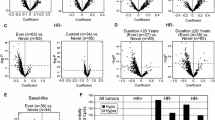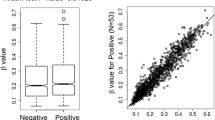Abstract
Aberrant DNA hypermethylation of gene promoter regions has been increasingly recognized as a common molecular alteration in carcinogenesis. We evaluated the association between major clinicopathological features and hypermethylation of genes in tumors among 803 incidence breast cancer cases from a large population-based case–control study conducted in Western New York State. DNA samples were isolated from archive paraffin embedded tumor tissue and were analyzed for hypermethylation status of the E-cadherin, p16, and RAR-β 2 genes using real time methylation-specific polymerase chain reaction. The frequencies of hypermethylation were 20.0% for E-cadherin, 25.9% for p16, and 27.5% for RAR-β 2 genes. For postmenopausal women, hypermethylation of E-cadherin tended to be more likely in progesterone receptor (PR) negative than in PR-positive tumors (odds ratio (OR), 1.41; 95% confidence interval (CI), 0.91–2.18). Hypermethylation of p16 tended to be more frequent among estrogen receptor (ER) negative cases than ER-positive cases (OR, 1.51; 95% CI, 1.01–2.32). Hypermethylation of RAR-β 2 gene was inversely associated with histological and nuclear grade of breast cancer.
Similar content being viewed by others
References
Wajed SA, Laird PW, DeMeester TR (2001) DNA methylation: an alternative pathway to cancer. Ann Surg 234:10–20
Baylin SB, Herman JG (2000) DNA hypermethylation in tumorigenesis: epigenetics joins genetics. Trends Genet 16:168–174
Esteller M, Corn PG, Baylin SB, Herman JG (2001) A gene hypermethylation profile of human cancer. Cancer Res 61:3225–3229
Esteller M, Silva JM, Dominguez G et al (2000) Promoter hypermethylation and BRCA1 inactivation in sporadic breast and ovarian tumors. J Natl Cancer Inst 92:564–569
Graff JR, Herman JG, Lapidus RG et al (1995) E-cadherin expression is silenced by DNA hypermethylation in human breast and prostate carcinomas. Cancer Res 55:5195–5199
Widschwendter M, Peter AJ (2002) DNA methylation and breast carcinogenesis. Oncogene 21:5462–5482
Raman V, Martensen SA, Reisman D et al (2000) Compromised HOXA5 function can limit p53 expression in human breast tumors. Nature 405:974–978
Wiley A, Katasaros D, Chen H et al (2006) Aberrant promoter methylation of multiple genes in malignant ovarian tumors and in ovarian tumors with low malignant potential. Cancer 107:299–308
Toyota M, Ahuja N, Suzuki H et al (1999) Aberrant methylation in gastric cancer associated with the CpG island methylator phenotype. Cancer Res 59:5438–5442
Bannon K, Yanokura M, Susumu N et al (2006) Relationship of the aberrant DNA hypermethylation of cancer-related genes with carcinogenesis of endometrial cancer. Oncol Rep 16:1189–1196
Jeong DH, Youm MY, Kim YN et al (2006) Promoter methylation of p16, DAPK, CDH1, and TIMP-3 genes in cervical cancer: correlation with clinicopathologic characteristics. Int J Gynecol Cancer 16:1234–1240
Belinsky SA, Liechty KC, Gentry FD et al (2006) Promoter hypermthylation of multiple genes in sputum precedes lung cancer incidence in a high-risk cohort. Cancer Res 66:3338–3344
Bae YK, Brown A, Garrett E et al (2004) Hypermethylation in histologically distinct classes of breast cancer. Clin Cancer Res 10:5988–6005
Li SY, Rong M, Iacopetta B (2006) DNA hypermethylation in breast cancer and its association with clinicopathological features. Cancer Lett 237:272–280
Shinozaki M, Hoon DSB, Giuliano AE et al (2005) Distinct hypermethylation profile of primary breast cancer is associated with sentinel lymph node metastasis. Clin Cancer Res 11:2156–2162
Parrella P, Poeta ML, Gallo AP et al (2004) Nonrandom distribution of aberrant promoter methylation of cancer-related genes in sporadic breast tumors. Clin Cancer Res 10:5349–5354
Garcia JM, Silva J, Pena C et al (2004) Promoter methylation of the PTEN gene is a common molecular change in breast cancer. Genes Chromosomes Cancer 41:117–124
Mehrotra J, Vali M, McVeigh M et al (2004) Very high frequency of hypermthylated genes in breast cancer metastasis to the bone, brain, and lung. Clin Cancer Res 10:3104–3109
Yan PS, Perry MR, Laux DE, Asare AL, Caldwell CW, Huang TH (2006) CpG island arrays: an application toward deciphering epigenetic signatures of breast cancer. Clin Cancer Res 6:1432–1438
Allred DC, Harvey JM, Berardo M, Clark GM (1998) Prognostic and predictive factors in breast cancer by immumohistochemical analysis. Mod Pathol 11:155–168
Tennis M, Krishnan S, Bonner M et al (2006) p53 Mutation analysis in breast tumors by a DNA microarray method. Cancer Epidemiol Biomarkers Prev 15:80–85
Jeronimo C, Usadel H, Henrique R et al (2001) Quantitation of GSTP1 methylation in non-neoplastic prostatic tissue and organ-confined prostate adenocarcinoma. J Natl Cancer Inst 93:1447–1452
Harden SV, Tokumaru Y, Westra WH et al (2003) Gene promoter hypermethylation in tumors and lymph nodes of stage 1 lung cancer patients. Clin Cancer Res 9:1370–1375
Usadel H, Brabender J, Danenberg KD et al (2002) Quantitative adenomatous polyposis coli promoter methylation analysis in tumor tissue, serum, and plasma DNA of patients with lung cancer. Cancer Res 62:371–375
Graff JR, Gabrelson E, Fujii H, Baylin SB, Herman JG (2000) Methylation patterns of the E-cadherin 5′ CpG island are unstable and reflect the dynamic heterogeneous loss of E-cadherin expression during metastatic progression. J Biol Chem 275:2727–2732
Hazan NM, Qiao R, Keren R, Badano I, Suyama K (2004) Cadherin switch in tumor progression. Ann N Y Acad Sci 1014:155–163
Rieger-Christ KM, Pezza JA, Dugan JM et al (2001) Disparate E-cadherin mutations in LCIS and associated invasive breast carcinomas. Mol Pathol 54:91–97
More H, Humar B, Weber W et al (2007) Identification of seven novel germline mutations in the human E-cadherin (CDH1) gene. Hum Mutat 28:203
Risinger JI, Berchuck A, Kohler MF, Boyd J (1994) Mutations of the E-cadherin gene in human gynecologic cancers. Nat Genet 7:98–102
Nass SJ, Herman JG, Gabrielson E et al (2000) Aberrant methylation of the estrogen receptor and E-cadherin 5′ CpG islands increases with malignant progression in human breast cancer. Cancer Res 60:4346–4348
Droufakou S, Deshmane V, Roylance R, Hanby A, Tomlinson I, Hart IR (2001) Multiple ways of silencing E-cadherin gene expression in lobular carcinoma of the breast. Int J Cancer 92:404–408
Caldeira JR, Prando EC, Quevedo FC, Neto FA, Rainho CA, Rogatto SR (2006) CDH1 promoter hypermethylation and E-cadherin protein expression in infiltrating breast cancer. BMC Cancer 6:48
Lipponen P, Saarelainen E, Ji H, Aaltomaa S, Syrjanen K (1994) Expression of E-cadherin (E-CD) as related to other prognostic factors and survival in breast cancer. J Pathol 174:101–109
Charpin C, Garcia S, Bouvier C et al (1997) E-cadherin quantitative immunocytochemical assays in breast carcinomas. J Pathol 181:294–300
Sherr CJ (1996) Cancer cell cycles. Science 274:1672–1677
Tlsty TD, Crawford YG, Holst CR et al (2004) Genetic and epigenetic changes in mammary epithelial cells may mimic early events in carcinogenesis. J Mammary Gland Biol Neoplasia 9:263–274
Holst CR, Nuovo GJ, Esteller M et al (2003) Methylation of p16(INK4a) promoters occurs in vivo in histologically normal human mammary epithelia. Cancer Res 63:1596–1601
Lewis CM, Cler LR, Bu DW et al (2005) Promoter hypermethylation in benign breast epithelium in relation to predicted breast cancer risk. Clin Cancer Res 11:166–172
Acknowledgements
This study would not have been possible without the support of all of the study participants and research staff of the Western New York Exposures and Breast Cancer (WEB) Study. Funding This work was funded by United States Public Health Service (USPHS) Grant Number R01CA92585 from the National Cancer Institute, and #DAMD 17030446 and #DAMD 179616202 from the DOD.
Author information
Authors and Affiliations
Corresponding authors
Additional information
An erratum to this article can be found online at http://dx.doi.org/10.1007/s10549-013-2660-5.
Rights and permissions
About this article
Cite this article
Tao, M.H., Shields, P.G., Nie, J. et al. DNA hypermethylation and clinicopathological features in breast cancer: the Western New York Exposures and Breast Cancer (WEB) Study. Breast Cancer Res Treat 114, 559–568 (2009). https://doi.org/10.1007/s10549-008-0028-z
Received:
Accepted:
Published:
Issue Date:
DOI: https://doi.org/10.1007/s10549-008-0028-z




